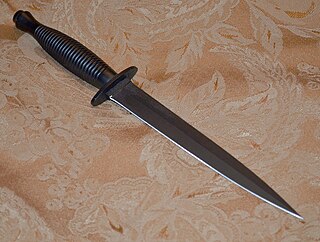
A dagger is a fighting knife with a very sharp point and usually one or two sharp edges, typically designed or capable of being used as a cutting or thrusting weapon. Daggers have been used throughout human history for close combat confrontations, and many cultures have used adorned daggers in ritual and ceremonial contexts. The distinctive shape and historic usage of the dagger have made it iconic and symbolic. A dagger in the modern sense is a weapon designed for close-proximity combat or self-defense; due to its use in historic weapon assemblages, it has associations with assassination and murders. Double-edged knives, however, play different sorts of roles in different social contexts.
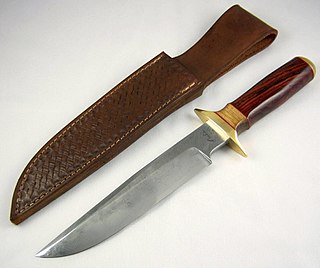
A knife is a tool or weapon with a cutting edge or blade, usually attached to a handle or hilt. One of the earliest tools used by humanity, knives appeared at least 2.5 million years ago, as evidenced by the Oldowan tools. Originally made of wood, bone, and stone, over the centuries, in step with improvements in both metallurgy and manufacturing, knife blades have been made from copper, bronze, iron, steel, ceramic, and titanium. Most modern knives have either fixed or folding blades; blade patterns and styles vary by maker and country of origin.

A bayonet is a knife, dagger, sword, or spike-shaped melee weapon designed to be mounted on the end of the barrel of a rifle, carbine, musket or similar long firearm, allowing the gun to be used as an improvised spear in close combats.

A smatchet is a short, heavy fighting knife 16.5 inches (42 cm) in overall length. It was designed by William E. Fairbairn during World War II.

A switchblade is a pocketknife with a sliding or pivoting blade contained in the handle which is extended automatically by a spring when a button, lever, or switch on the handle or bolster is activated. Virtually all switchblades incorporate a locking blade, where the blade is locked against accidental closure when the blade is in the open position. It is unlocked by a mechanism that allows the blade to be folded and locked in the closed position.
A stiletto is a specialized dagger with a long slender blade and needle-like point, primarily intended as a thrusting and stabbing weapon.

A trench knife is a combat knife designed to kill or incapacitate an enemy at close quarters, such as in a trench or other confined area. It was developed as a close combat weapon for soldiers attacking enemy trenches during the First World War. An example of a World War I trench knife is the German Army's Nahkampfmesser.
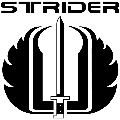
Strider Knives, Inc. is a custom and production knifemaking facility headed by Mickey Ray Burger, founded and based in San Marcos, California.
A combat knife is a fighting knife designed for military use and primarily intended for hand-to-hand or close combat fighting.

The Fairbairn–Sykes fighting knife is a double-edged fighting knife resembling a dagger or poignard with a foil grip. It was developed by William Ewart Fairbairn and Eric Anthony Sykes in Shanghai based on ideas that the two men had while serving on the Shanghai Municipal Police in China before World War II.
A knife fight is a violent physical confrontation between two or more combatants in which one or more participants are armed with a knife. A knife fight is defined by the presence of a knife as a weapon and the violent intent of the combatants to kill or incapacitate each other; the participants may be completely untrained, self-taught, or trained in one or more formal or informal systems of knife fighting. Knife fights may involve the use of any type of knife, though certain knives, termed fighting knives, are purposely designed for such confrontations – the dagger being just one example.
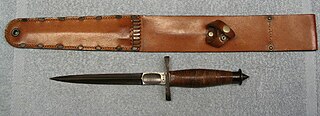
The V-42 stiletto was a fighting knife issued during World War II to the First Special Service Force, a joint American/Canadian commando unit.
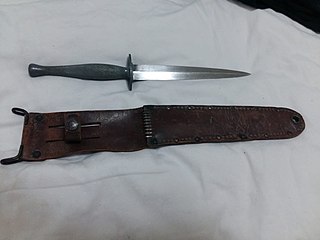
The United States Marine Raider stiletto was issued to the Marine Raiders and 1st Canadian Parachute Battalion during World War II.
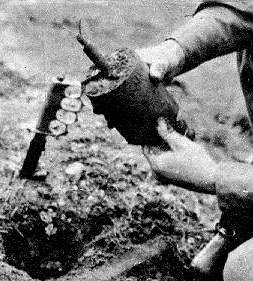
The Mark I trench knife is an American trench knife designed by officers of the American Expeditionary Force (AEF) for use in World War I. It has a 6.75 in (17.1 cm) double-edged dagger blade useful for both thrusting and slashing strokes, unlike previous U.S. trench knives such as the M1917 and M1918. The handle is made of cast bronze and uses a conical steel nut to hold the blade in place. The Mark I's blade was blued with a black oxide finish, the bronze handle was chemically blackened, with cast spikes on the bow of each knuckle. The spikes were intended to prevent an opponent from grabbing the knife hand, as well as to provide a more concentrated striking surface when employed in hand-to-hand combat.

The M3 trench knife or M3 fighting knife was an American military combat knife first issued in March 1943. The M3 was originally designated for issue to soldiers, not otherwise equipped with a bayonet. However, it was particularly designed for use by forces in need of a close combat knife, such as Airborne Units and Army Rangers, so these units received priority for the M3 at the start of production. As more M3 knives became available in 1943 and 1944, the knife was issued to other soldiers such as Army Air Corps crewmen and soldiers not otherwise equipped with a bayonet, including soldiers issued the M1 carbine or a submachine gun such as the M3 submachine gun "grease gun".
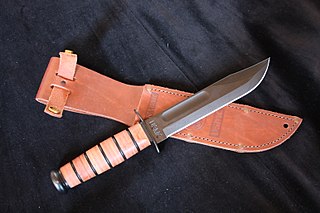
Ka-Bar is the contemporary popular name for the combat knife first adopted by the United States Marine Corps in November 1942 as the 1219C2 combat knife, and subsequently adopted by the United States Navy as the U.S. Navy utility knife, Mark 2. Ka-Bar is the name of a related knife manufacturing company, Ka-Bar Knives., Inc., of Olean, New York, a subsidiary of the Cutco Corporation.
Gil Hibben is an American custom knifemaker from Wyoming who is based in La Grange, Kentucky. Hibben designed the first line of Browning hunting knives in 1968, the American Kenpo Knife for Ed Parker, and the Rambo Knife for the 1988 film Rambo III 2008 film Rambo. Hibben's "Fantasy Knives" have been used in over 37 films and television shows, particularly science fiction, earning him the title "Klingon Armorer" from the Star Trek franchise. Hibben currently serves as a President of the Knifemakers' Guild, a post he has held for fourteen years.

A fighting knife has a blade designed to most effectively inflict injury in close-quarters physical confrontations. The combat knife and the trench knife are examples of military fighting knives.
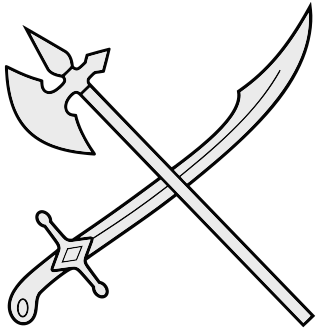
An edged weapon, or bladed weapon, is a melee weapon with a cutting edge. Bladed weapons include swords, daggers, knives, and bayonets. Edged weapons are used to cut, hack, or slash; some edged weapons may also permit thrusting and stabbing. Edged weapons contrast with blunt weapons such as maces, and with pointed weapons such as spears.















